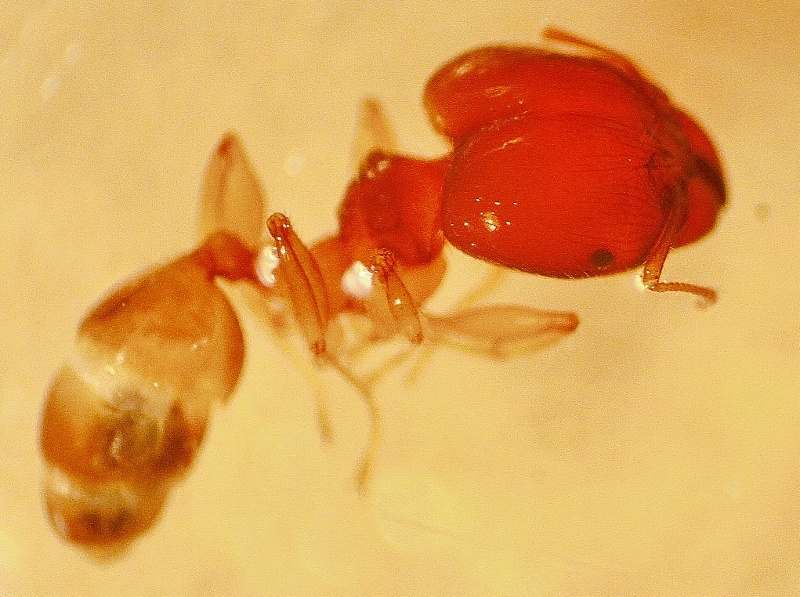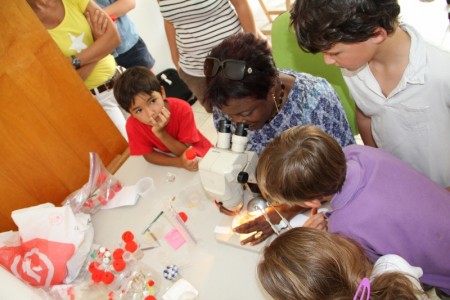Progressing in THE INVENTORY OF ANTS AND TERMITs

Since 2010, the association has initiated a program for studying the biodiversity of our island and its preservation; a knowledge very important for setting up spatial planning policies.
The insects representing a large part of this biodiversity and therefore a part of the natural heritage of the island, in 2011, the association asked Léonide Celini, a PhD entomologist, to make the inventories of ants and termites. We asked her to establish the list of ants & temits’ taxa and to set up a collection reference for scientific purpose and a collection for educational purposes even if we all know that the inventories must continue in time. Because they give indications on the current state of the biodiversity. Because new species can appear, disappear or become rare.
At the present time, there is no official list of St Barth’s ants & termits species. Probably due to the lack of specialists on the island and the fact that until 2007, the island was a commune of Guadeloupe. Therefore, the rare taxa collected had been included in the list of Guadeloupe species, which itself, is also very incomplete. Data on ant and termits’ taxa in the Caribbean are also patchy because taxonomic identification keys are often non-existent or unclear.
Between 2011 & 2012, Dr Celini carried out two field missions : from June 20 to July 7, 2011 and from April 14 to April 24, 2012. Her objectives was to establish the list of taxa and to create a base for their taxonomic identifications which will be completed with the molecular data that will be provided by Dr. Roy who works simultaneously on these taxa at the University Paris Est Créteil.
During these two missions, educational outings open to all, followed by introductory sessions on magnifying taxonomic determination were held.

We also have explored different environments : open, anthropized, highly urbanized (inside Gustavia) in order to have a good representation of the specific diversity of ants and termites. We have explored Gouverneur, (tip of Gouverneur), Saint Jean (“castle area”), Grand Cul de Sac, Petit Cul de Sac (seaside with sandy environment), Grand Fond (pass & Morne la Croix), Grand Fond (near the sea), Colombier, Flamands, Hauts de St Jean, Merlet, Lurin, Gustavia.
Specimens were either sighted or trapped (Malaise trap, pilltrap) and then placed either in 70 ° alcohol for taxonomic identification or in 100° alcohol for molecular identification.
HOW DETERMINATION WORKS
The taxonomic determination is based on morphological characteristic. The specimens are determined till the species if possible and then designated by two names in Latin: genus and species – it is the binomial nomenclature.
If possible, the identified specimen will be compared with the specimen of the same name in reference collections. In our case, we consulted the collection of the National Museum of Natural History in Paris or for some samples, specimens of references belonging to certain specialists referents of the group.
In the species of the New World the difficulty is such that there has been much confusion of synonymy and multiple revisions within genera and species. Therefore, the taxonomic status of certain species is complex and still insufficiently resolved with the morphological information.
That’s why molecular determination is so interesting. To do so, we use the molecular barcode. A molecular barcode is a DNA fragment whose amino acid sequence is almost identical in individuals belonging to the same species. It thus makes it possible to determine the species to which belongs an individual knowing only the sequence of this fragment.
One can thus identify a specimen by comparing its sequence with those of the known species. Thus, in a first step, we compare the sequence obtained for the ant species and termits that we chosed to validate, with the sequence published by GENBANK for the same species (BLAST Program). If this sequence is not published, the specimen may belong to either a species that has not yet been sequenced or is a new species. In this case we can know the nearest sequences which have been sequenced and published. In our case, we referenced certain taxa and asked for a GENBANK accession number.
25 SPECIES OF ANTS
In 2011, we collected 20 species of ants. In 2012, 5 other species, bringing the total to 25 species, some of which were unpublished for Saint-Barthelemy and some West Indies Islands. Six of these species are described as invasive. An ant is said to be invasive when it is outside its distribution area and where it has been introduced either intentionally or accidentally (trade exchange, nurseries trade, transport of contaminated substrates : trunks, wood). It becomes an agent of disturbance, harmful to the native biodiversity of the ecosystems where it is established. It can also replace some original species, rare or endangered species.Invasive ants often have economic, environmental and health impacts.
In the island 5 species are commonly encountered :
- The Tropical fire ant, Solenopsis geminata. It inflicts nuisances on humans and pets; it can also damage plastic tubes. In the wild, it maintains insects producing honeydew (aphid insects) and can thus promote viral diseases on plants.
- The big-headed ant, Pheidole megacephala, represents a serious threat to biodiversity. It is also an agricultural pest (consumption of seeds) and does a lot of domestic damage (irrigation installations, telephone wiring, electrical wires). It is on the IUCN ‘s list of the 100 most invasive species in the world.
- Two other ants, are common in urban areas, but do not hold the attention because they do not sting human:
- The “ghost ant”, Tapinoma melanocephalum owes its name to its whitish abdomen; it has a strong smell reminiscent of coconut when crushed.
- The “crazy ant”, Paratrechina longicornis, is recognizable by its long legs and great agility.
These two ants often invade homes and buildings and can carry pathogenic microorganisms in hospital settings.
Other species are more discreet but very dangerous because they infest houses beds, linens, electrical sheaths, switches, counters) and inflict painful stings. These are the case of 2 small ants originating from South America:
- The little ant fire Wasmannia auropunctata whose bites can blind animals (dogs and cats, turtles).
- As well as the great fire ant, Solenopsis invicta, considered as one of the most harmful ant species of the planet. In South America, it is responsible for economic, environmental and sanitary ravages. It bites and stings by injecting an exceptional venom because there can be deaths of sensitive people (80 people killed in 2006 in Alabama).
In the wild, these ants can significantly reduce populations of insects, arachnids or birds. The great fire ant can even repel higher vertebrates.
We must also point out the recent presence in the island of the invasive fungus Antharmonic Acromyrmex octospinosus called “Cassava ant”. It is a great pest of plants and has been classified by IUCN as the most dangerous invasive species in Guadeloupe. It was reported to Saint-Barthélemy in 2010 but it is likely that it was present well before. Our work on molecular phylogeny has shown that it comes from Guadeloupe.
This shows the need for phytosanitary controls, if we want to preserve the biodiversity of the island.